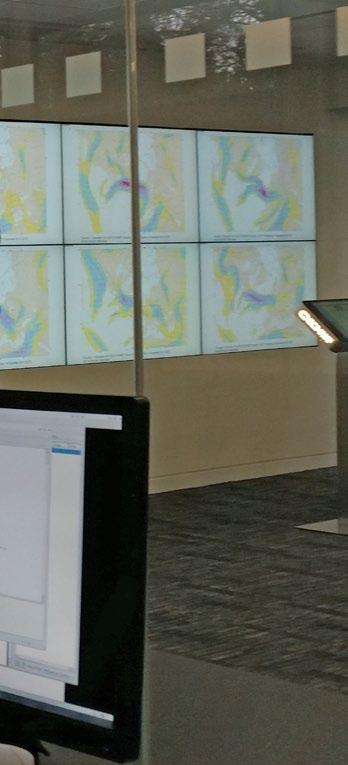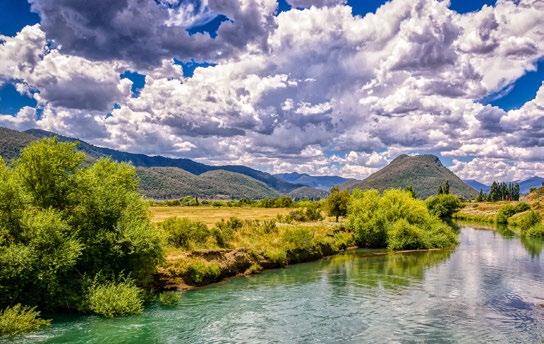
14 minute read
We hear from Dr Peter Bauer
Users will be from all sectors: traditional weather, climate and environmental services, civil protection, food, water, energy, etc.
ECMWF Weather Room
parent challenges that extremes and climate change have on our society. Some of this had been already proposed in a project called ExtremeEarth a few years ago and several publications over the years. The presently emerging novel digital technologies supporting high-performance computing, big data handling, cloud computing, artificial intelligence and machine learning present new opportunities to scale up what we are presently able to do and create a much more powerful, open and interactive way of digitally replicating the Earth-system and use this information in support of better policymaking for the green transition.

Can you tell us about the planned timeline and milestones of Destination Earth?
Destination Earth will be kicked off in mid-2021 and its first phase will last 30 months. However, we expect it to stretch throughout the entire EC funding framework period 2021-2027. The first phase will be an implementation phase, in which the digital twins, the core service platform and the data lake will be set up and connected. The initial digital twins will focus on weather-induced and geophysical extremes and climate change adaptation. The core service platform will be the access portal for everything that Destination Earth produces and the data lake is Destination Earth’s virtual data repository. Phase 2, after 30 months, will then start production, scale-up these infrastructure components and increasingly widen user access, openness for data and models.

Who are the potential users of the model? How will it be made available?
The users will be from all sectors affected by extremes and climate change – from both public and private entities. That includes traditional weather, climate and environmental services, civil protection, food, water, energy, health and finance/insurance. The programme will make available data, models and services through its service platform that allows interactive access to Destination Earth data and models. This will guarantee interoperability and open and free access.
What are the sources of the data fed into the digital twin, and how will it be kept up to date throughout the years?
Destination Earth will use and disseminate the vast amounts of diverse observational data from satellites, surface networks, balloons, buoys etc. that our weather and climate community has been used to ingesting for decades. Both the volume and diversity of this data are growing rapidly. In addition, new observational data sources like IoT will be explored. A major data source will be Earth-system simulations based on very high-resolution models that we aim to combine with the observations such that we can produce the best possible representation of the Earth system at any given point in time and location.
To what extent do you think the destination Earth initiative will help integrate green transition efforts across different sectors that depend on Earth data such as the water or the agricultural sectors?
This is actually one of the main aims of Destination Earth as it will look at the Earth system – including the human sphere related to food and water management – in a holistic way. This should provide a much more integrated tool for planning policy measures and controlling their effectiveness.
Where does Europe stand versus the rest of the world in terms of global-scale simulation and modelling?
The global Earth-system modelling community is very well connected and there is a strong exchange between centres all over the world to advance our joint capabilities. An example of this is the strong role of the World Meteorological Organization in running joint development and operational programmes that also help disseminate developments across the globe. The quality of global weather and climate predictions is rather similar between the leading centres of the world, and it is important to maintain a common push for more realistic models and enhanced predictive skill.
Where do you see the Destination Earth initiative 20 years from now?
As a fully operational, highly accessible data analysis and modelling platform giving access to the best available simulation models combined with vast observational datasets, continually updated and fully connect to impact sectors like food, water, energy and health: the best possible digital replica of the Earth system monitoring the past and present and predicting the future.
DESIGN FIRM STANTEC LAUNCHES ITS INSTITUTE FOR WATER TECHNOLOGY & POLICY
The Institute will identify emerging technologies to address water challenges and bridge the gap between science and practice

Global design firm Stantec has unveiled its newest initiative – the Stantec Institute for Water Technology & Policy (the Institute) – to explore the real-world impacts of a changing climate on the sustainability of water and the role of emerging technologies in water science and policy. The Institute engages scientists, engineers, and technology specialists across the globe to investigate questions at the forefront of transforming the water industry’s future. Of paramount importance is capitalizing on opportunities that accelerate sustainability and resiliency within the changing global climate, specifically through addressing the nexus of food, water, and energy by focusing on decarbonization and the circular economy.
Many water systems are grappling with aging and deteriorating infrastructure, changing customer bases, regulatory compliance, and climate change – all of which add to the growing costs of providing affordable and equitable water services. Many of the technical problems facing our water industry are solvable through the implementation of suitable policy and emerging technology. However, the pace of research and commercialization is not fast enough in many cases. And because the publicly owned water industry has tended to be risk averse, early adopters of water technology or new approaches often pay a premium to be first.
“A primary mission of the Institute is to identify emerging and leading-edge technologies to help address the water challenges our communities face and bridge the gap between science and practice to de-risk their implementation. The Institute exists to demonstrate that solutions to preserve and protect water quantity and quality in the context of a changing global climate are both technologically available and achievable at any scale,” said Dr Art Umble, Stantec Senior Vice President, Global Sector Leader for Wastewater Treatment.
The Institute will function as a connector – through work with experts at regional utilities, industrial water users, academic institutions, industry organizations, and technology providers – to explore technology-based solutions that reach across the entire hydrologic cycle.
The Institute will leverage the firm’s breadth of expertise and strategic partnerships across the areas of water resources, water quantity, water quality, and water conveyance and their intersection with public and environmental policy. At the centre of the Institute’s activity is science-based data that will help inform decision makers setting water policy and addressing regulatory issues.
“Our reputation is built on our experience working on some of the world’s largest and most technically challenging projects,” said Dr Rob Simm, Senior Vice President, Emergent Sector Leader. “We are in a unique position to help establish these critical connections due to our global reach and, most importantly, the strength and depth of our relationships across the water technology, venture capital, vendor, academic, and industry communities.”
CLIMATE CHANGE INFLUENCES RIVER FLOW, AN INDICATOR OF AVAILABLE WATER RESOURCES
River flow has changed significantly worldwide in recent decades. An international research team led by ETH Zurich has now demonstrated that it is climate change, rather than water and land management, that plays a crucial role at a global level.
Climate change is affecting the water balance of our planet: depending on the region and the time of year, this can influence the amount of water in rivers resulting in more flooding or drought. River flow is an important indicator of water resources available to humans and the environment. The amount of available water also depends on further factors, such as direct interventions in the water cycle or land use change: if, for example, water is diverted for irrigation or regulated via reservoirs, or forests are cleared and monocultures grown in their place, this can have an impact on river flow.
However, how river flow has changed worldwide in recent years was so far not investigated using direct observations. Similarly, the question of whether globally visible changes are attributable to climate change or water and land management had not been clarified.
Now, an international research team led by ETH Zurich has broken down the influence of these factors, after analysing data from 7,250 measuring stations worldwide. The study, which has been published in the scientific journal Science, demonstrates that river flow changed systematically between 1971 and 2010. Complex patterns were revealed – some regions such as the Mediterranean and north-eastern Brazil had become drier, while elsewhere the volume of water had increased, such as in Scandinavia.
“The actual question, however, concerned the cause of this change,” says Lukas Gudmundsson, lead author and senior assistant in the group led by Sonia Seneviratne, professor at the Institute for Atmospheric and Climate Science at ETH Zurich.
To answer this question, the researchers carried out computer simulations, using global hydrological models fed with observed climate data from the period 1971 to 2010. The results of the model calculations matched the analysis of observed river flow. “This means that climatic conditions can explain the observed trends in the flow volumes”, says Gudmundsson. In a second procedure, the researchers included additional water and land management in their simulations in order to study the influence of these factors. This did not affect the result, however. “Changes in water and land management are evidently not the cause of global changes in rivers”, he says.
Although water management and land use can result in large local fluctuations in flow volumes, investigating it was not within the scope of the study, adds Gudmundsson: “For us, it was not about local trends but global changes that become visible over longer periods.” This is why the researchers did not consider data from individual measuring stations in isolation, but collated them into subcontinental regions for the analysis, making it possible to identify the influence of climate change.

SEVERAL STATES IN WESTERN U.S. LOOK AT CLOUD SEEDING TO TACKLE DROUGHT
Researchers have shown cloud seeding technology can be used to generate snow, though it does not solve the root causes of drought Reliable and resilient water systems will protect vulnerable communities

As the western U.S. continues to experience an ongoing drought, weather modification interventions to prompt precipitation are appealing to more states, reports The Guardian. At least eight states are now considering the use of cloud seeding to bring about precipitation. Interest in the technology is mounting across the world as global temperatures rise and drought risks increase.
In the Colorado Basin, about $1.5 million are invested in cloud seeding every year, with costs shared by state agencies in Colorado, Utah and Wyoming, as well as Nevada, California, New Mexico and Arizona. Until recently, there were many unknowns as to how well the technology works. Statistical studies have shown it may produce around 5 to 15% more snowfall, at a lower cost than water recycling or desalination.
Recent research is providing new insight into how efficient cloud seeding is. Katja Friedrich, from the University of Colorado, Boulder, helped lead the SNOWIE project. “We can now finally put a number on how much water we can produce through cloud seeding”, she said. However, researchers caution that even though it is possible to generate snow, they have not shown it is possible to overcome drought.
In fact, experts point out cloud seeding does not solve the root causes of drought and it’s unknown how it might work in a warming climate. It can be used to increase the water supply as part of a broader water resources plan that involves water demand as well as water supply management measures. WaterAid’s latest report: Turn the tide: The state of the world’s water 2021 shows how people are losing access to clean water as droughts dry up springs, sea levels rise and landslides destroy water pumps. The international development organization shows investing in water systems that provide a reliable supply, regardless of the weather, is a frontline defence against the impacts of climate change.
In the crucial battle to reduce global emissions, the situation faced now by those most impacted by climate change has been given little focus or investment. Without easy access to clean water, people’s lives are blighted by sickness, poverty and the endless drudgery of collecting water.
For water, climate change acts as a threat multiplier, exacerbating problems caused by poor management of water resources, lack of political will and inadequate investment. With the current climate scenario, UN Water has predicted that water scarcity will displace between 24 million and 700 million people, by 2030. One in ten people worldwide do not have clean water close to home. The hours spent collecting water or recovering from waterborne illnesses robs entire communities of an opportunity to build a better future.
Currently, only 5% of total global climate funding is spent on helping countries adapt to a changing climate, and that money is not targeted to communities most vulnerable to climate change. The most climate vulnerable countries receive just $1 per person per year for investment in water.
WATER AID REPORT WARNS CLIMATE CHANGE THREATENS CLEAN WATER FOR WORLD'S POOREST

RACHAEL MCDONNELL
STRATEGIC PROGRAM DIRECTOR – WATER, CLIMATE CHANGE AND RESILIENCE, IWMI
PREPARING FOR DROUGHT IN THE WORLD’S MOST WATER-STRESSED REGION
The pandemic aside, the past year saw natural disasters on an In Jordan, Lebanon and Morocco, the MENAdrought project has unprecedented scale bringing misery and millions of dollars of brought together experts in water management, modelling and destruction across the globe. Wildfires raged across the west- remote sensing, water planning and others to provide policymakern United States, while a hyperabundant summer monsoon ers, water managers and engineers with the training, data, tools brought floods and economic loss to much of southern China. and planning skills they need to cope with future water shortages.
Scientific assessments link the increased intensity of these MENAdrought rests on three pillars: monitoring and earextreme events to human-induced climate change. But climate ly-warning systems; impact and vulnerability assessments; and change brings other impacts that do not grab headlines. Rains elevating the importance of drought mitigation, response and that are weeks late, until they finally arrive and are too sparse preparedness. and the growing season too short to harvest a normal crop. Too IWMI partnered with the US National Drought Mitigation little water can do as much damage as too much. Center at the University of Nebraska-Lincoln to adapt their
Agriculture, which uses 70% of global fresh water, is the most drought monitoring system to local conditions. Crucially, naobvious victim of drought, but it is enmeshed in a complex nex- tional partners were involved in the process so that they can us of interdependent sectors. Urbanization and economic devel- make use of satellite data locally while sustaining the effort and opment depend on water too, and improving the modelling for their because changing water regimes have far-reaching consequences in The International Water specific needs. A crucial planning tool is an Eneach sector, the management of wa- Management Institute (IWMI) hanced Composite Drought Index ter resources is becoming more vital and more difficult. has been leading a USAID- (eCDI), which takes observations from satellites, along with locally
About one-third of the world’s funded project to deliver the specific historical data, to enable population lives in places subject to water scarcity, and droughts are basis for improved planning evidence-based choices. The eCDI, plus newly developed artificial ina natural part of the water cycle in telligence (AI)-enhanced seasonal many places. In the Middle East and North Africa (MENA), rainfall forecasting, gives scientific guidance for when to declare the most water-stressed region in the world, drought is an ev- a drought and when to trigger emergency relief. The geographer-present threat. Even a small fall in the availability of water ical specificity and local accuracy of the eCDI means that early threatens aspects of daily life, and drought multiplies existing mitigation can be directed to areas in greatest need, forestalling threats, amplifying tensions within the region. greater problems later on.
Climate change will make droughts more frequent and Throughout the project, an overriding concern has been to perhaps more severe. Proactive drought management is more ensure close cooperation of water utilities and various governeffective and less expensive than crisis-led responses, which is ment departments responsible for sectors such as agriculture, why better planning and preparedness are vitally important. health and industry. As a crucial element in the entire wa-
We can no longer rely on the past as a guide to help us plan ter-food-energy nexus, integrated management is essential for for the future. As water managers learn to contend with the water and food security. Our work with MENAdrought has new normal, they need better models and tools. shown that proactive, evidence-based drought decision-making
The International Water Management Institute has been leading can make a difference, with results that will be valuable far bea USAID-funded project to deliver the basis for improved planning. yond the Middle East and North Africa.




